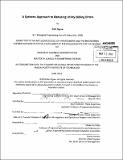| dc.contributor.advisor | Mort Webster and Georgia Perakis. | en_US |
| dc.contributor.author | Ogura, Nori | en_US |
| dc.contributor.other | Leaders for Global Operations Program. | en_US |
| dc.date.accessioned | 2013-09-24T19:36:47Z | |
| dc.date.available | 2013-09-24T19:36:47Z | |
| dc.date.copyright | 2013 | en_US |
| dc.date.issued | 2013 | en_US |
| dc.identifier.uri | http://hdl.handle.net/1721.1/81010 | |
| dc.description | Thesis (M.B.A.)--Massachusetts Institute of Technology, Sloan School of Management; and, (S.M.)--Massachusetts Institute of Technology, Engineering Systems Division; in conjunction with the Leaders for Global Operations Program at MIT, 2013. | en_US |
| dc.description | Cataloged from PDF version of thesis. | en_US |
| dc.description | Includes bibliographical references (p. 63-64). | en_US |
| dc.description.abstract | Many methods for analyzing the possibility of errors are practiced by organizations who are concerned about safety and error prevention. However, in situations where the error occurrence is random and difficult to track, the rate of errors at a particular instant in time is not a practical metric of hazardous conditions (or whether a system may be vulnerable to errors). Qualitative indicators (such as stress levels) that are easier to observe, but difficult to measure, may be linked to the dynamic behavior of quantitative indicators that are easier to measure using System Dynamics models. In this work, we propose a method to find an appropriate metric for error analysis, by determining the direct quantitative triggers associated with the qualitative indicators of hazardous conditions. A System Dynamics model is generated for determining the measurable quantitative indicator behaviors linked to more apparent qualitative factors for determining the health of a system. Used in concert with other system methodologies, it gives insight into triggers and policies for developing and implementing improvement processes. The context of this research is in reducing billing errors at a utility company which for confidentiality reasons we refer to as United Energy. We use several system methodologies including System Dynamics and Safety System Analysis, to assess the billing operation system and process, to develop a project management plan for the development and implementation of a tool to reduce billing errors. | en_US |
| dc.description.statementofresponsibility | by Nori Ogura. | en_US |
| dc.format.extent | 64 p. | en_US |
| dc.language.iso | eng | en_US |
| dc.publisher | Massachusetts Institute of Technology | en_US |
| dc.rights | M.I.T. theses are protected by
copyright. They may be viewed from this source for any purpose, but
reproduction or distribution in any format is prohibited without written
permission. See provided URL for inquiries about permission. | en_US |
| dc.rights.uri | http://dspace.mit.edu/handle/1721.1/7582 | en_US |
| dc.subject | Sloan School of Management. | en_US |
| dc.subject | Engineering Systems Division. | en_US |
| dc.subject | Leaders for Global Operations Program. | en_US |
| dc.title | A systems approach to reducing utility billing errors | en_US |
| dc.type | Thesis | en_US |
| dc.description.degree | S.M. | en_US |
| dc.description.degree | M.B.A. | en_US |
| dc.contributor.department | Leaders for Global Operations Program at MIT | en_US |
| dc.contributor.department | Massachusetts Institute of Technology. Engineering Systems Division | |
| dc.contributor.department | Sloan School of Management | |
| dc.identifier.oclc | 857790055 | en_US |
